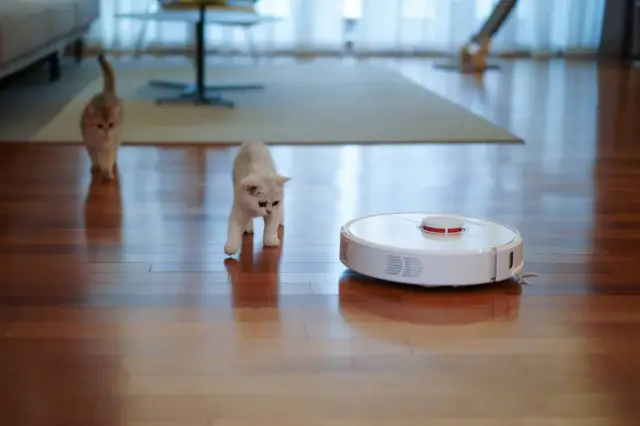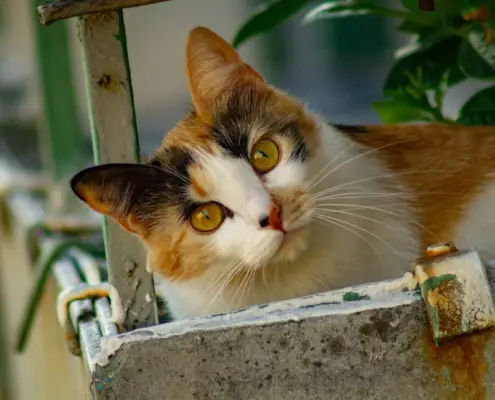
Cats are known for their curious and independent nature, but when it comes to one particular household appliance, they often exhibit fear and anxiety – the vacuum cleaner. The sight and sound of a vacuum can send cats scurrying for cover, leaving pet owners puzzled and concerned. Understanding the psychology behind cats’ fear of vacuums is the first step in helping them overcome this common phobia.
The psychology behind cats’ fear of vacuums
To comprehend why cats fear vacuums, it’s crucial to delve into their natural instincts and sensory perceptions. Cats have highly sensitive hearing and acute senses, which make them more susceptible to loud and sudden noises. The noise produced by a vacuum cleaner can be overwhelming for their delicate ears, triggering a flight response. Additionally, the unfamiliar appearance and movement of the vacuum can be perceived as a threat in the cat’s mind, activating their innate survival instincts.
Moreover, cats are creatures of habit and thrive on routine and predictability. The sudden disruption caused by the vacuum cleaner can disrupt their sense of security and stability, leading to fear and anxiety. It’s essential to recognize that each cat is unique, and their individual experiences and temperament can influence the intensity of their fear response.
Signs that your cat is afraid of the vacuum
As a pet owner, it’s crucial to be able to identify the signs of fear and anxiety in your cat when it comes to vacuum cleaners. Some common indicators include:
- Hiding or fleeing: Your cat may seek refuge in hiding spots or bolt to another room when the vacuum is turned on.
- Tense body posture: Anxious cats may exhibit a visibly tense body posture, with their fur standing on end and their tail curled tightly.
- Vocalizations: Cats may vocalize their distress through hissing, growling, or meowing excessively when the vacuum is in use.
- Pacing or restlessness: Fearful cats may exhibit signs of restlessness, pacing back and forth in an attempt to find a safe space.
- Avoidance behavior: Cats may actively avoid areas where the vacuum cleaner is present, such as the room where it is stored or the space being cleaned.
Recognizing these signs can help you address your cat’s fear in a timely manner and provide the necessary support to help them overcome it.
Why are cats afraid of vacuums?
The fear of vacuums in cats can be attributed to a combination of factors, including their innate instincts, sensory sensitivity, and past experiences. Cats have a natural instinct to be cautious around unfamiliar objects, as they associate them with potential threats. The loud noise and sudden movements of a vacuum cleaner can trigger their flight response, as they perceive it as a threat to their safety.
Furthermore, cats have a keen sense of hearing, and the noise produced by a vacuum cleaner can be overwhelming for them. The high-pitched sound and the intensity of the noise can cause discomfort and anxiety, reinforcing their fear response. Additionally, if a cat has had a negative experience with a vacuum in the past, such as being startled or accidentally injured by it, it can contribute to the development of a fear or phobia.
How to help your cat overcome their fear of vacuums
While cats’ fear of vacuums may seem challenging to overcome, there are several strategies and techniques that can help your furry friend feel more at ease in the presence of this common household appliance. Here are some effective methods:
Desensitization techniques for cats afraid of vacuums
Desensitization is a gradual process that involves exposing your cat to the vacuum cleaner in a controlled and positive manner. Start by placing the vacuum in a stationary position and allowing your cat to approach it at their own pace. Reward them with treats and praise for calm behavior. Gradually introduce the sound of the vacuum by turning it on at a low volume while offering treats and positive reinforcement. Over time, increase the duration and intensity of exposure, always ensuring that your cat feels safe and comfortable throughout the process.
Creating a safe space for your cat during vacuuming
Providing a designated safe space for your cat during vacuuming sessions can significantly alleviate their anxiety. Set up a cozy area in a quiet room where your cat can retreat to during cleaning sessions. Ensure the space is equipped with their favorite toys, bedding, and a hiding spot. Allow your cat to access this area freely and encourage them to use it by offering treats and creating a positive association with the space. This will provide them with a sense of security and control during a potentially stressful time.
Alternative cleaning methods to reduce your cat’s fear
In some cases, it may be worth considering alternative cleaning methods to minimize your cat’s fear of vacuums. Manual cleaning tools such as brooms, dustpans, or lint rollers can be used to remove pet hair and debris without the need for a vacuum cleaner. Additionally, there are specialized pet hair removal tools available that use static electricity or rubber bristles to efficiently clean surfaces. Experiment with different cleaning methods to find one that is effective and less anxiety-inducing for your cat.
Seeking professional help for cats with severe vacuum phobia
If your cat’s fear of vacuums is severe or persistent, it may be beneficial to seek professional help from a veterinarian or animal behaviorist. These experts can assess your cat’s specific needs and develop a tailored behavior modification plan to address their fear. They may recommend additional techniques such as counter-conditioning, medication, or the use of pheromone diffusers to help your cat manage their anxiety.
Empathy and patience are key in helping your cat overcome their fear
In conclusion, the fear of vacuums in cats is a common issue that can be addressed with understanding and patience. By recognizing the signs of fear, understanding the psychology behind it, and implementing appropriate techniques, you can help your cat overcome their fear and create a more harmonious environment for both of you. Remember to approach the process with empathy and respect for your cat’s individual needs, and celebrate their progress along the way. With time and consistent effort, your feline companion can learn to feel more secure and relaxed in the presence of the vacuum cleaner.
If you enjoyed my article, I would appreciate you sharing it with your network.

Sima Ndlebe
Sima writes for CatBuzz. He is interested in Cats, Health and Fitness, and Entrepreneurship.
Published: 6 December 2023




